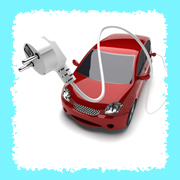Tell Me More Energy Science-SMART! Home
Electric Vehicles
 Electric vehicles (EVs) include cars, trucks, vans, buses, trolleys, light-rail, subways, and bicycles. All EVs have an electric motor that turns the wheels and a lead acid, nickel cadmium, or nickel metal hydride battery to run the motor. Most EVs employ regenerative braking, which allows some of the kinetic energy to be stored in the vehicle while decelerating. To accomplish this, the motor is operated as a generator, providing braking torque to the wheels and recharging the traction batteries. This energy can then be used for propulsion or to power vehicle accessories.
Electric vehicles (EVs) include cars, trucks, vans, buses, trolleys, light-rail, subways, and bicycles. All EVs have an electric motor that turns the wheels and a lead acid, nickel cadmium, or nickel metal hydride battery to run the motor. Most EVs employ regenerative braking, which allows some of the kinetic energy to be stored in the vehicle while decelerating. To accomplish this, the motor is operated as a generator, providing braking torque to the wheels and recharging the traction batteries. This energy can then be used for propulsion or to power vehicle accessories.
Hybrid electric vehicles (HEVs) have batteries to provide electric power, plus a small internal combustion engine usually powered by gasoline of diesel. The batteries get recharged from the gasoline or diesel engine, which shuts down completely at stoplights. While braking, kinetic energy is converted into electricity and then stored in the battery.



